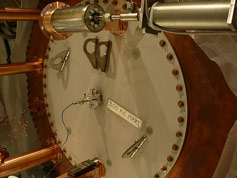
Handy Links
SLAC News Center
SLAC Today
- Subscribe
- Archives: Feb 2006-May 20, 2011
- Archives: May 23, 2011 and later
- Submit Feedback or Story Ideas
- About SLAC Today
SLAC News
Lab News
- Interactions
- Lightsources.org
- ILC NewsLine
- Int'l Science Grid This Week
- Fermilab Today
- Berkeley Lab News
- @brookhaven TODAY
- DOE Pulse
- CERN Courier
- DESY inForm
- US / LHC
SLAC Links
- Emergency
- Safety
- Policy Repository
- Site Entry Form

- Site Maps
- M & O Review
- Computing Status & Calendar
- SLAC Colloquium
- SLACspeak
- SLACspace
- SLAC Logo
- Café Menu
- Flea Market
- Web E-mail
- Marguerite Shuttle
- Discount Commuter Passes
-
Award Reporting Form
- SPIRES
- SciDoc
- Activity Groups
- Library
Stanford
Around the Bay
Extraordinary EXO
 Later this year, the prototype Enriched Xenon Observatory (EXO) will be shipped to the New Mexico desert and lowered 2,100 feet below ground in an old mining elevator. For now, though, the observatory is in a cavernous hall on
the Stanford campus, ensconced in a set of modular clean rooms to protect the equipment from radioactive materials, including human skin cells.
Later this year, the prototype Enriched Xenon Observatory (EXO) will be shipped to the New Mexico desert and lowered 2,100 feet below ground in an old mining elevator. For now, though, the observatory is in a cavernous hall on
the Stanford campus, ensconced in a set of modular clean rooms to protect the equipment from radioactive materials, including human skin cells.
The observatory will search for something never seen before: a neutrinoless double beta decay, a radioactive decay that turns xenon136 into barium136 and two electrons without emitting any neutrinos. Finding neutrinoless decays will prove that neutrinos are their own anti-particle, and will tell scientists more about the mass of these nearly massless particles.
To get to the heart of the observatory, you first pull on bright white tennis shoes, turquoise gloves and a cleanroom suit. After suiting up, you enter a chamber where puffs of air from the walls blow away dust. In the innermost room, a cylindrical cryostat contains the cooling system to keep xenon—normally a noble gas—in a liquid state at about 185 degrees Fahrenheit below the freezing point of water. The detector, still being assembled in a nearby clean room, will fit inside the cryostat.
Because xenon is three times denser than water, 330 pounds of xenon can fit into the 15-inches-long by 15-inches-diameter detector. The xenon is carefully enriched to contain 80 percent of the isotope xenon136 with Russian ultracentrifuges, which filtered out most of the heavier and lighter xenon atoms. Xenon136 cannot undergo ordinary beta decay—its only choice is double beta decay, with or without neutrinos.
Xenon136 is very stable. In 1019 years (1 trillion times 10 million years) only half the atoms will undergo radioactive decay. Scientists expect these double beta decays—which usually involve emitting neutrinos—to occur about 800 times a day for every ton of xenon136. Something like one in a million of these decays will be neutrinoless. The prototype observatory "might expect to see just a handful of events in a couple of years at best," said EXO researcher Peter Rowson.
Each decay will create a signal in the pool of xenon when the emitted electrons ionize the xenon atoms and generate scintillation light. Wires and photo diodes throughout the pool will detect the signals. To make sure electrons from other sources don't give false signals, the observatory needs to be shielded from radioactively produced electrons (once called beta particles)—hence its placement deep in a New Mexican salt mine.
Stanford leads the project, with participation from SLAC and other institutions.
—Heather Rock Woods, April 2, 2007
Above image: The EXO cryostat.